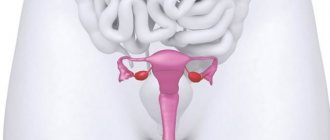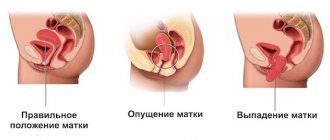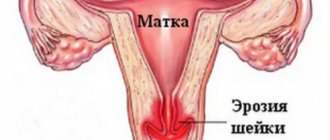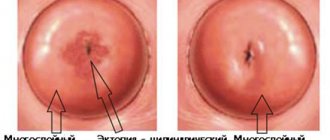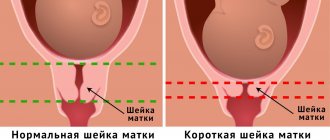While carrying a child, every female representative's immune system weakens significantly, hormone levels change, and a number of other unfavorable disorders occur in the body. As a result of this, the risk of negative diseases or various abnormalities that can provoke complicated childbirth increases significantly. As a rule, in case of such complications (ruptures, lesions of the mucous membrane of the uterine cervix, etc.), during the birth of a baby, doctors use many auxiliary tools that will allow you to safely remove the child from the mother’s womb and minimize harm to her health. But, based on medical statistics, the result of such manipulations is the occurrence of cervical erosion after childbirth, which can cause a lot of discomfort if it is not treated in time.
Let's figure out whether cervical erosion is dangerous for women's health and how to effectively and quickly eliminate it.
Features of the pathology
Cervical erosion is a so-called defect of the mucous membrane in this area, which can occur as a result of many factors (traumatic or pathological). As a rule, a lesion that appears before the age of 20 is a normal malfunction in the body that occurs during adolescence and such an injury to the uterine cervix most often goes away on its own. If erosion has formed in older female representatives, this means that it is impossible to do without qualified treatment tactics. The most common cause of such damage is childbirth. A wound area on the mucosal surface can form as a result of traumatic exposure, which is provided at the time of birth of the child.
Why does the disease appear?
The causes of cervical erosion are varied. Most often, the disease occurs in women who have given birth. It is especially pronounced if the birth was very difficult. Therefore, cervical erosion in women who have given birth is caused by the following factors:
- If during natural childbirth the cervix opens weakly, this can cause rupture of the internal tissues of the organ. Sometimes doctors don't notice these small lesions, so they grow over time, leading to illness.
- Rapid labor or an overly large fetus can also lead to pathology. Since as a result of this, ruptures are also possible.
- Surgical intervention by a doctor during or after the birth process often causes erosion. Scars may not heal well, inflammation or infection may appear, which causes the disease.
- The birth of a premature or post-term baby can also provoke cervical erosion after childbirth. In the first case, the walls of the organ do not open well, and in the second, the fetus is too large. This causes numerous difficult-to-heal ruptures.
In addition, when pregnancy occurs, a woman’s immunity sharply decreases. Therefore, her body is more susceptible to infection by various infections, including sexually transmitted ones. So during pregnancy you cannot have sex without a condom. In general, it is recommended to have sexual intercourse only after consultation with an obstetrician-gynecologist.
Causes
Postpartum erosion may appear for the following reasons:
- the rapid process of childbirth with slow dilatation of the cervix;
- excessively large fetus size;
- the presence of traces of scarring on the mucous membrane (surgical interventions that were performed in the past);
- penetration of various types of infections into the resulting gaps and their further progression and reproduction;
- the presence of diseases of the genitourinary system;
- deterioration of the epithelium inside the cervix, which occurs as a result of hormonal imbalance.
The above list of reasons is considered the most common; it is possible that erosion can also occur due to other factors. The true provocateur of this disease is identified by a qualified medical professional.
Diagnostics
Diagnosis of cervical erosion should be made by an experienced specialist in a medical facility. It consists of the following research procedures:
- thorough gynecological examination;
- detailed analysis of a vaginal smear;
- studying the condition of the genitourinary organs using a colposcope;
- study of the mucous membrane of the uterine cervix under a microscope.
After completing the diagnostic examination and studying the results, a qualified physician will prescribe the most highly effective treatment for erosion and associated diseases (if present).
Diagnosis of the disease
The main thing in diagnosis is to identify the nature of changes that occur at the cellular level, the absence or presence of atypical processes in tissues.
Medicine has four diagnostic methods:
- Examination of a smear taken from the cervix and vagina to determine the composition of its microflora. A light microscope helps to identify the cleanliness of the vagina, the number of leukocytes, the alkaline environment, the predominance of trichomonas, staphylococci over beneficial microbes;
- Colposcopy . This method allows you to examine organs by illuminating their individual areas and optical magnification;
- Bacterial culture is used to determine a specific type of bacteria to determine their sensitivity to drugs;
- PCR test - a smear to detect pathogens using molecular biology methods that are sexually transmitted: syphilis, gonorrhea, trichomoniasis. When determining the DNA of organisms, it is possible to calculate their number and accurately determine their type.
Let's tell you more about:
- clinical picture and treatment of the disease depending on its size;
- treatment tactics for women who have given birth;
- medicinal methods;
- preparation for cauterization, analysis;
- Is it painful to cauterize;
- discharge, dangers and consequences, useful recommendations after the procedure.
Symptoms of the disease
Erosion after childbirth at the initial stage, as a rule, progresses without any pronounced manifestations. But if it is not detected in time, the following unpleasant signs may occur:
- menstrual irregularities;
- the presence of discomfort in the genital area;
- excessively intense secretion of unnatural color and consistency;
- pain in the lower abdomen;
- presence of foul odor from the vagina;
- deterioration of the general condition of women's health;
- there may be itching in the genitourinary area;
- the presence of pain during sexual intercourse.
If the above symptoms appear, you should immediately visit your doctor.
Causes of postpartum erosion
The cervix is an important component of the female reproductive system. In simple words, it connects the vagina to the uterus. During childbirth, the cervix grows approximately ten times, and then shrinks to its original parameters. The cervical reduction process takes approximately eight weeks. After its restoration, all previous scars, wounds, lesions turn out to be ten times larger than they were.
Obstetricians-gynecologists identify different reasons for the appearance of erosion after the birth of the first child, all of them are associated with the complex course of the birth process, which was caused by:
- heavy weight of the child;
- first pregnancy at an immature age;
- childbirth after thirty-five years;
- post-term pregnancy;
- sexual diseases not cured in time;
- multiple abortions before pregnancy;
- quick birth;
- the occurrence of sexually transmitted infections during pregnancy.
How dangerous is the disease?
To be aware of the consequences of the disease, every woman should know what cervical erosion looks like and what can happen if it is not eliminated in time. Since ectopia is a so-called wound area on the mucous membrane, if you don’t care about its progression, it can increase in diameter and undergo various inflammations. The larger the size of the wound, the more difficult it is to choose safe treatment methods that will not harm the health of the female representative.
Read more in Cervical erosion - is it dangerous?
If the diameter of the ectopia is small, drug treatment is possible, which is considered practically harmless to the woman’s reproductive function, and if the pathology has reached a large size, then cauterization of the cervical erosion will be required to treat it. The consequence of such a procedure is damage to the soft tissue and its scarring, which, in turn, prevents the subsequent conception of the child, its gestation and birth.
How to treat cervical erosion after childbirth
Treatment methods for cervical erosion can be very diverse and should be prescribed exclusively by a qualified gynecologist based on the diagnostic results obtained. At the initial stage of the disease and when the ectopia has not yet reached large sizes, doctors prescribe therapy with pharmacological drugs, vaginal suppositories and tampons, and also, in some cases, resort to treatment with folk remedies. In situations where the damage to the mucous membrane is in a more advanced state, cauterization of the wound is indispensable. To choose the most effective and appropriate method, the doctor must understand whether the victim intends to have children in the future, since some treatment methods adversely affect the woman’s reproductive function.
Exposure to radio waves
One of the safest methods of cauterization, which involves non-contact exposure to radio wave radiation on the affected cells that have formed in the cavity of the uterine cervix.
Laser vaporization
The most highly effective method of therapy, which is also not dangerous for the future health of women and the reproductive system of the female representative. The essence of the procedure is to influence the resulting ectopia using a device that emits laser beams, without affecting the nearby, undamaged soft tissue.
Chemical coagulation
It is used, as a rule, at the initial stage of development of the disease, when the pathology is shallow and has a small diameter. During this therapeutic procedure, special chemicals act on the affected tissue cells, painlessly accelerating the process of their regeneration.
Diathermocoagulation
The oldest and most dangerous method of treatment, which is indicated only for women who have given birth and who do not intend to become mothers in the future. This treatment is aimed at eliminating erosion using high voltage electric current. At the time of such a procedure, the affected tissue of the uterine cervix is affected, but damage to healthy parts of the epithelium is also possible. The most common consequence of this electrical coagulation is scarring of the mucous membrane in the cervix, which causes a narrowing of the passage, preventing the fetus from passing through this area normally.
Cryodestruction
Cryodestruction is a painless medical procedure for eliminating ectopia, which is based on the use of a special apparatus that produces liquid nitrogen. Such manipulation should be performed exclusively by an experienced specialist, who will ensure that the flow of cold is directed only to the affected area of the epithelium, otherwise scarring and damage to healthy tissue cells is possible.
ethnoscience
Medical professionals do not recommend self-medication, but it is possible to use folk remedies for cervical erosion in conjunction with complex drug treatment. Common recipes:
- one spoon of dried calendula flowers must be poured into two glasses of boiled water, left for 30 minutes, strained and used as a douche;
- 4 tbsp. l. dried St. John's wort flowers must be poured with two liters of boiling water and boiled for another ten minutes, left for another half hour, strained and also used as a douche for two weeks.
Tampons
It is not uncommon to use tampons soaked in decoctions and medicinal liquids to combat the resulting erosion, which relieve inflammation and accelerate the healing process of the wound area on the mucous membrane. The most common recipes:
- aloe juice with honey. 20 milliliters of honey and 3 teaspoons of aloe leaf juice are mixed into a homogeneous liquid, 3-4 drops of castor oil are added and a tampon is soaked in this drug for 3-5 minutes. Every day, for two weeks, the woman inserts a tampon into the vagina for the whole night;
- rosehip oil. Every night for 14 days, the girl needs to soak a personal hygiene product in rosehip oil and insert it into the vaginal cavity;
- sea buckthorn oil. The course of therapy should last no less than ten days and end only when, during a gynecological examination, the doctor notifies that the erosion and all its accompanying symptoms have completely disappeared. To prepare such a medicinal product, it is necessary to grind a certain amount of sea buckthorn fruits, pour them with any kind of vegetable oil (1:5) and keep them cooking in a water bath for four hours. After preparation, cool the resulting liquid, moisten a tampon in it and place it into the vaginal cavity every night.
Argon plasma coagulation
An equally effective method of cauterization, at the moment of which the effect occurs using the released gas - argon. It does an excellent job of restoring affected areas of the epithelium in the cervical cavity, stops minor hemorrhages and, with a quality approach, can reduce the risk of developing soft tissue scarring.
- Learn more about how to treat cervical erosion.
Postpartum ectropion
After a complicated birth and various mechanical damage during it, in addition to cervical erosion, a disease such as cervical ectropion may occur. This pathology has similar symptoms to ectopia and is characterized by the occurrence of eversion of the mucous membrane of the uterine cervix into the vaginal cavity. The progression of such a defect requires the immediate intervention of experienced specialists, as it also threatens the development of dangerous complications, including deterioration of the woman’s reproductive function, and can interfere with the subsequent ability to become pregnant. This disease is treated with conservative and surgical intervention; the method of therapy and subsequent prognosis completely depend on the stage of progression and the diameter of the soft tissue lesion.
Erosion after childbirth and new pregnancy
If a female representative has been diagnosed with ectopia and she intends to have children in the future, then a qualified medical worker must select a treatment method that will not in any way affect the reproductive function of the expectant mother. As a rule, in such cases, non-contact and gentle cauterization methods (radio wave and laser) or treatment of the lesion using pharmacological agents and traditional medicine are prescribed. It is also very important that at least one and a half years pass after treating erosion in the uterine cervix and conceiving a child.
Masha Khmeleva
if the erosion is extensive, what should you expect? Until it develops into something? There’s nothing wrong with cauterization, I gave birth after erosion myself. And my friend never cauterized and had a cesarean because... The cervix did not open.
and what does it have to do with it if you are not going to give birth in the next 2 years????? I was going to give birth, was preparing for B and cauterized anyway, a month later I became pregnant. Cauterization does not affect B. And in 2 years are you sure that she will not outgrow it? I, too, in 2008, was afraid to cauterize, I thought I was giving birth. Then I’ll cauterize, saying I was young, but the nurse said there was only one young woman here. She died of cancer at the age of 25, too... I thought I’d give birth, then I’ll cauterize it…..
erosion is not a normal condition, these are bad cells.
cauterize and don’t think about it and be sure to get tested for cytology before cauterization, this is not a biopsy, they’ll just scrape your erosion (your cells) with a brush and see if there’s dysplasia. DYSPLASIA is a precancerous condition and there are different degrees. 1,2 can still be treated normally, but anything more requires surgery.
Don’t drag out such things for a long time. I’m telling you this because my mother acquired both erosion and mastopathy. And all this later developed into cancer. A year and a half ago, my mother died of cancer, first her breasts were taken away, then her intestines I was operated on, and then I had cervical cancer (this is what erosion causes). Now I get examined every six months and just run to an ultrasound, take cytology tests, cauterize the erosion. I’ve already had 2 of them!!!!!!
Our ecology cannot be left untreated for too long.
it’s your health!! even if the Europeans don’t get treatment there, even if they don’t give birth, it’s their problem.
Take care of yourself!!!! your children need you
my mother did not undergo treatment and left me at 22 years old alone and my 9 year old brother!!! and she was 42 years old! I wish I could live and live
